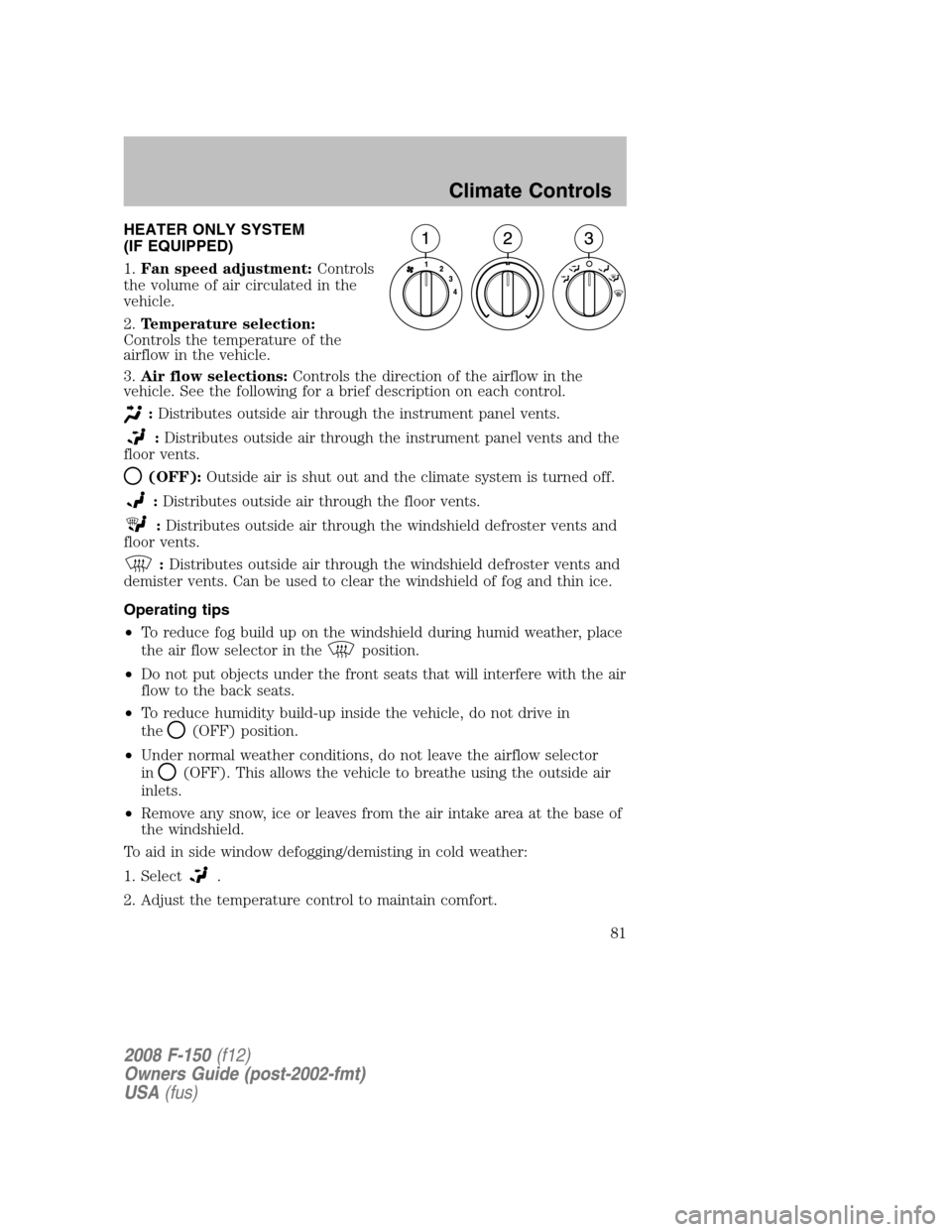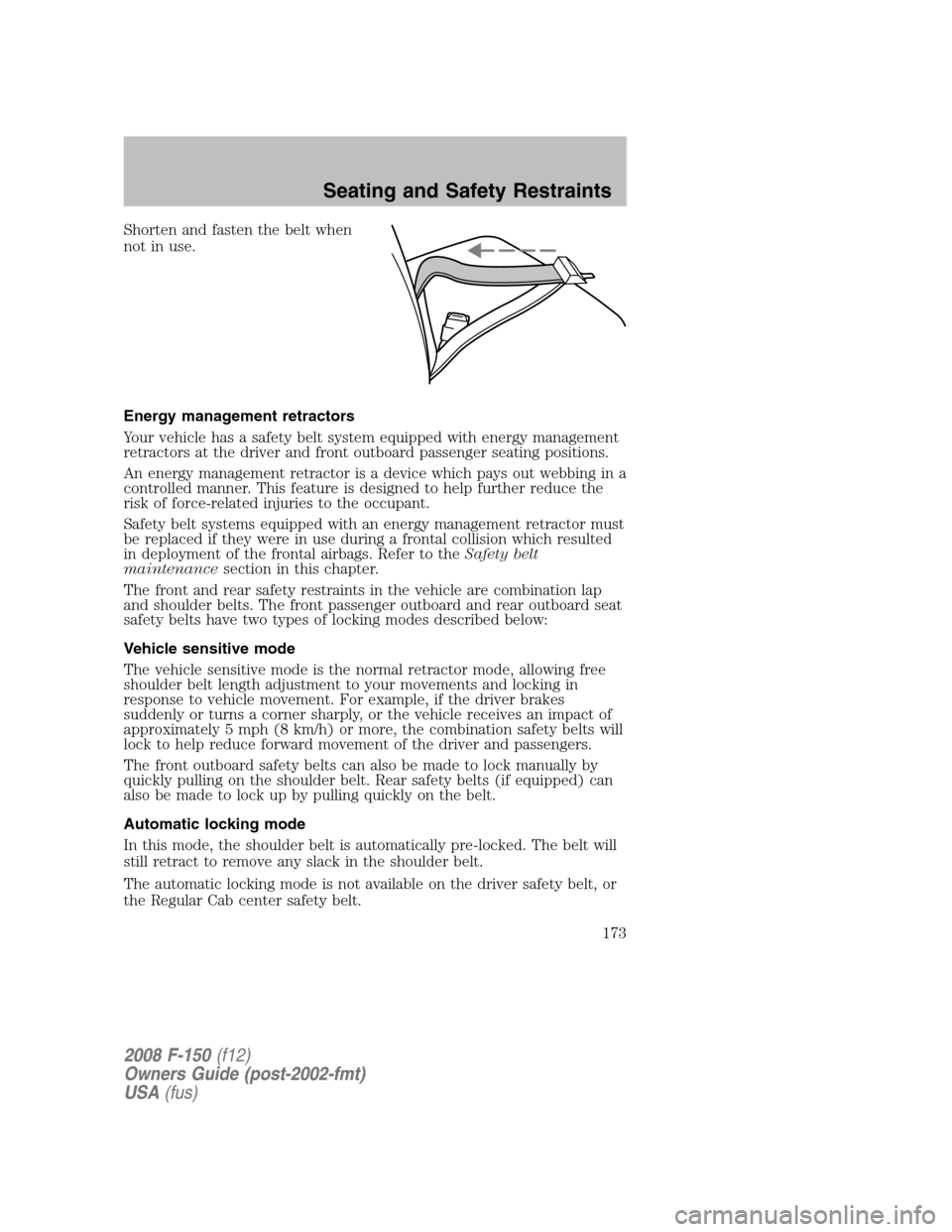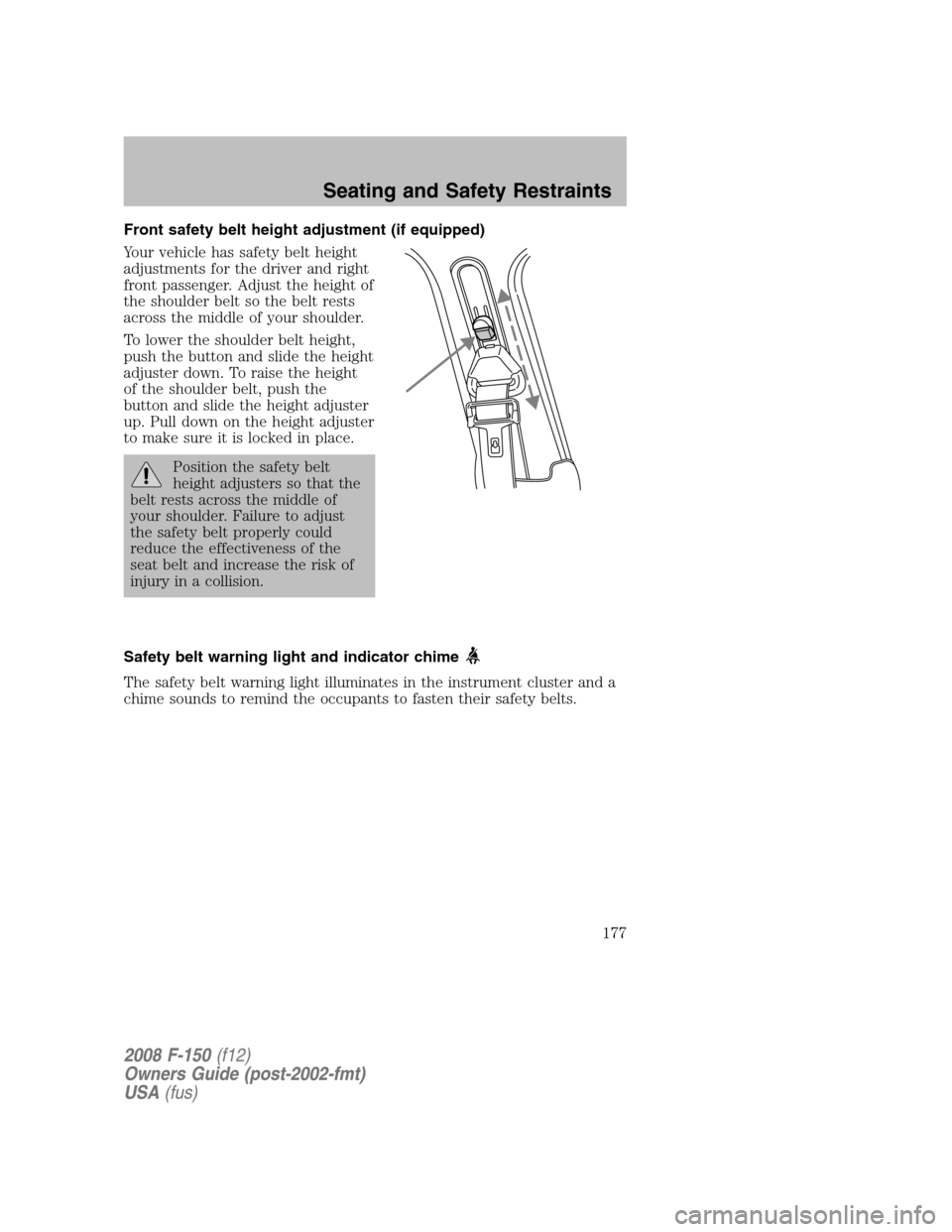seat adjustment FORD F150 2008 11.G Owners Manual
[x] Cancel search | Manufacturer: FORD, Model Year: 2008, Model line: F150, Model: FORD F150 2008 11.GPages: 400, PDF Size: 3.94 MB
Page 81 of 400

HEATER ONLY SYSTEM
(IF EQUIPPED)
1.Fan speed adjustment:Controls
the volume of air circulated in the
vehicle.
2.Temperature selection:
Controls the temperature of the
airflow in the vehicle.
3.Air flow selections:Controls the direction of the airflow in the
vehicle. See the following for a brief description on each control.
:Distributes outside air through the instrument panel vents.
:Distributes outside air through the instrument panel vents and the
floor vents.
(OFF):Outside air is shut out and the climate system is turned off.
:Distributes outside air through the floor vents.
:Distributes outside air through the windshield defroster vents and
floor vents.
:Distributes outside air through the windshield defroster vents and
demister vents. Can be used to clear the windshield of fog and thin ice.
Operating tips
•To reduce fog build up on the windshield during humid weather, place
the air flow selector in the
position.
•Do not put objects under the front seats that will interfere with the air
flow to the back seats.
•To reduce humidity build-up inside the vehicle, do not drive in
the
(OFF) position.
•Under normal weather conditions, do not leave the airflow selector
in
(OFF). This allows the vehicle to breathe using the outside air
inlets.
•Remove any snow, ice or leaves from the air intake area at the base of
the windshield.
To aid in side window defogging/demisting in cold weather:
1. Select
.
2. Adjust the temperature control to maintain comfort.
2008 F-150(f12)
Owners Guide (post-2002-fmt)
USA(fus)
Climate Controls
81
Page 83 of 400

3. A.RRear defroster (if equipped):Press to defrost the rear
window. Refer toRear window defrosterlater in this chapter for more
information.
3. B.Heated mirrors (if equipped):Press to activate/deactivate. This
function will clear snow, fog and thin ice from the side rear view mirrors.
4.Recirculation control
: Press to activate/deactivate air
recirculation in cabin. Recirculated air may reduce the amount of time to
cool down the interior of the vehicle and may also help reduce undesired
odors from reaching the interior of the vehicle. Recirculation engages
automatically with selection of MAX A/C or can be engaged manually in
any other airflow selection except defrost. Recirculation may turn off
automatically in all airflow selections except MAX A/C.
5.A/C:Press to activate/deactivate air conditioning. Use with
recirculated air to improve cooling performance. Engages automatically
in MAX A/C, Defrost and Floor/Defrost.
6.Fan speed adjustment:Controls the volume of air circulated in the
vehicle.
Operating tips
•To reduce fog build up on the windshield during humid weather, place
the air flow selector in the
(defrost) or(floor/defrost)
position.
•To reduce humidity build up inside the vehicle: do not drive with the
airflow selector in the
(OFF) or with recirculated air engaged.
•Do not put objects under the front seats that will interfere with the
airflow to the back seats.
•Remove any snow, ice or leaves from the air intake area at the base of
the windshield.
•To improve the A/C cool down, drive with the windows slightly open
for 2-3 minutes after start up or until the vehicle has been “aired out.”
•For maximum cooling performance (Max A/C):
Max A/C mode:
•Move the temperature control to the coolest setting.
•Set the fan to the highest speed initially, then adjust to maintain
comfort.
2008 F-150(f12)
Owners Guide (post-2002-fmt)
USA(fus)
Climate Controls
83
Page 173 of 400

Shorten and fasten the belt when
not in use.
Energy management retractors
Your vehicle has a safety belt system equipped with energy management
retractors at the driver and front outboard passenger seating positions.
An energy management retractor is a device which pays out webbing in a
controlled manner. This feature is designed to help further reduce the
risk of force-related injuries to the occupant.
Safety belt systems equipped with an energy management retractor must
be replaced if they were in use during a frontal collision which resulted
in deployment of the frontal airbags. Refer to theSafety belt
maintenancesection in this chapter.
The front and rear safety restraints in the vehicle are combination lap
and shoulder belts. The front passenger outboard and rear outboard seat
safety belts have two types of locking modes described below:
Vehicle sensitive mode
The vehicle sensitive mode is the normal retractor mode, allowing free
shoulder belt length adjustment to your movements and locking in
response to vehicle movement. For example, if the driver brakes
suddenly or turns a corner sharply, or the vehicle receives an impact of
approximately 5 mph (8 km/h) or more, the combination safety belts will
lock to help reduce forward movement of the driver and passengers.
The front outboard safety belts can also be made to lock manually by
quickly pulling on the shoulder belt. Rear safety belts (if equipped) can
also be made to lock up by pulling quickly on the belt.
Automatic locking mode
In this mode, the shoulder belt is automatically pre-locked. The belt will
still retract to remove any slack in the shoulder belt.
The automatic locking mode is not available on the driver safety belt, or
the Regular Cab center safety belt.
2008 F-150(f12)
Owners Guide (post-2002-fmt)
USA(fus)
Seating and Safety Restraints
173
Page 177 of 400

Front safety belt height adjustment (if equipped)
Your vehicle has safety belt height
adjustments for the driver and right
front passenger. Adjust the height of
the shoulder belt so the belt rests
across the middle of your shoulder.
To lower the shoulder belt height,
push the button and slide the height
adjuster down. To raise the height
of the shoulder belt, push the
button and slide the height adjuster
up. Pull down on the height adjuster
to make sure it is locked in place.
Position the safety belt
height adjusters so that the
belt rests across the middle of
your shoulder. Failure to adjust
the safety belt properly could
reduce the effectiveness of the
seat belt and increase the risk of
injury in a collision.
Safety belt warning light and indicator chime
The safety belt warning light illuminates in the instrument cluster and a
chime sounds to remind the occupants to fasten their safety belts.
2008 F-150(f12)
Owners Guide (post-2002-fmt)
USA(fus)
Seating and Safety Restraints
177
Page 392 of 400

Child safety seats - booster
seats ...........................................193
Cleaning your vehicle
engine compartment ..............331
instrument panel ............333–334
interior .....................................335
plastic parts ............................332
safety belts ..............................335
washing ....................................329
waxing .....................................330
wheels ......................................330
wiper blades ............................333
Climate control (see
Air conditioning or
Heating) ...........................81, 85, 87
Clock adjust
6-CD in dash .............................38
AM/FM Stereo ...........................28
AM/FM/CD .................................31
Clutch
fluid ..........................................371
operation while driving ..........275
recommended shift speeds ....276
Compass, electronic ..........123, 125
calibration ...............................125
set zone adjustment .......125–126
Console ......................................104
overhead ..........................104–105
Controls
power seat ...............................160
steering column ......................117
Coolant
checking and adding ..............351
refill capacities ................355, 381
specifications ..........................381
Cruise control
(see Speed control) ..................115
Customer Assistance ................296Ford Extended Service
Plan ..........................................325
Getting assistance outside
the U.S. and Canada ..............326
Getting roadside assistance ...296
Getting the service
you need .................................321
Ordering additional
owner’s literature ...................327
Utilizing the Mediation/
Arbitration Program ...............325
D
Daytime running lamps
(see Lamps) ................................92
Dipstick
automatic transmission
fluid ..........................................372
engine oil .................................345
Driveline universal joint
and slip yoke .............................377
Driving under special
conditions ..................275, 287, 290
sand .........................................289
snow and ice ...........................291
through water .................289, 292
DVD system .................................51
E
Electronic message center .......125
Emergencies, roadside
jump-starting ..........................315
Emergency Flashers .................298
Emission control system ..........368
Engine ........................................385
cleaning ...................................331
coolant .....................................351
fail-safe cooling .......................356
2008 F-150(f12)
Owners Guide (post-2002-fmt)
USA(fus)
Index
392